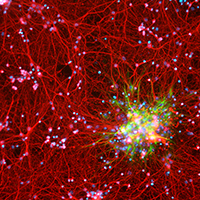Quantitative, structural and molecular changes in neuroglia of aging mammals: A review

Accepted: 27 May 2021
HTML: 11
All claims expressed in this article are solely those of the authors and do not necessarily represent those of their affiliated organizations, or those of the publisher, the editors and the reviewers. Any product that may be evaluated in this article or claim that may be made by its manufacturer is not guaranteed or endorsed by the publisher.
Authors
The neuroglia of the central and peripheral nervous systems undergo numerous changes during normal aging. Astrocytes become hypertrophic and accumulate intermediate filaments. Oligodendrocytes and Schwann cells undergo alterations that are often accompanied by degenerative changes to the myelin sheath. In microglia, proliferation in response to injury, motility of cell processes, ability to migrate to sites of neural injury, and phagocytic and autophagic capabilities are reduced. In sensory ganglia, the number and extent of gaps between perineuronal satellite cells – that leave the surfaces of sensory ganglion neurons directly exposed to basal lamina– increase significantly. The molecular profiles of neuroglia also change in old age, which, in view of the interactions between neurons and neuroglia, have negative consequences for important physiological processes in the nervous system. Since neuroglia actively participate in numerous nervous system processes, it is likely that not only neurons but also neuroglia will prove to be useful targets for interventions to prevent, reverse or slow the behavioral changes and cognitive decline that often accompany senescence.
How to Cite
PAGEPress has chosen to apply the Creative Commons Attribution NonCommercial 4.0 International License (CC BY-NC 4.0) to all manuscripts to be published.
Similar Articles
- G Natale, G Lazzeri, C Blandizzi, M Ferrucci, M Del Tacca, Differential distribution of transforming growth factor-a immunohistochemistry within whole gastric mucosa in rats , European Journal of Histochemistry: Vol. 47 No. 4 (2003)
- G Silvestrini, P Mocetti, R Di Grezia, S Berni, E Bonucci, Localization of the glucocorticoid receptor mRNA in cartilage and bone cells of the rat. An in situ hybridization study , European Journal of Histochemistry: Vol. 47 No. 3 (2003)
- P Pagliara, R Lanubile, M Dwikat, L Abbro, L Dini, Differentiation of monocytic U937 cells under static magnetic field exposure , European Journal of Histochemistry: Vol. 49 No. 1 (2005)
- Xin-Wei Liu, Bin Ma, Ying Zi, Liang-Bi Xiang, Tian-Yu Han, Effects of rutin on osteoblast MC3T3-E1 differentiation, ALP activity and Runx2 protein expression , European Journal of Histochemistry: Vol. 65 No. 1 (2021)
- Paolo Flace, Diana Galletta, Antonella Bizzoca, Gianfranco Gennarini, Paolo Livrea, A candidate projective neuron type of the cerebellar cortex: the synarmotic neuron , European Journal of Histochemistry: Vol. 68 No. 2 (2024)
- N. Accart, J. Dawson, F. Kolbinger, I. Kramer, N. Beckmann, Non-invasive imaging demonstrates clinical features of ankylosing spondylitis in a rat adjuvant model: a case study , European Journal of Histochemistry: Vol. 60 No. 4 (2016)
- R Bugorsky, JC Perriard, G Vassalli, Genetic selection system allowing monitoring of myofibrillogenesis in living cardiomyocytes derived from mouse embryonic stem cells , European Journal of Histochemistry: Vol. 52 No. 1 (2008)
- Chiara Rita Inguscio, Barbara Cisterna, Maria Assunta Lacavalla, Franco Donati, Osvaldo Angelini, Gabriele Tabaracci, Manuela Malatesta, Ozone and procaine increase secretion of platelet-derived factors in platelet-rich plasma , European Journal of Histochemistry: Vol. 67 No. 4 (2023)
- Marco Biggiogera, The Feulgen reaction at the electron microscopy level , European Journal of Histochemistry: Vol. 68 No. 1 (2024): 1954-2024: 70 Years of Histochemical Research
- Yao Le, Zhijun Wang, Qian Zhang, Ling Miao, Xiaohong Wang, Guorong Han, Study on the mechanism of Shenling Baizhu powder on the pathogenesis of pregnancy complicated with non-alcoholic fatty liver, based on PI3K/AKT/mTOR signal pathway , European Journal of Histochemistry: Vol. 68 No. 3 (2024)
<< < 50 51 52 53 54 55 56 57 58 59 > >>
You may also start an advanced similarity search for this article.

 https://doi.org/10.4081/ejh.2021.3249
https://doi.org/10.4081/ejh.2021.3249










